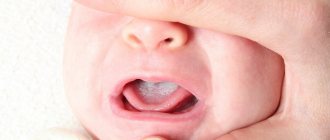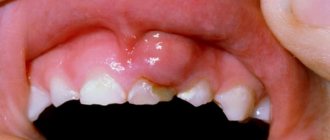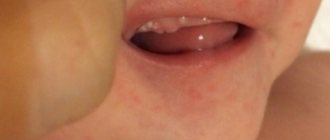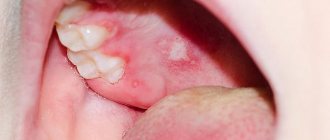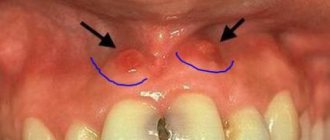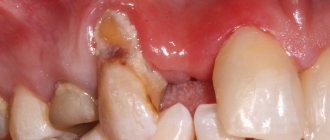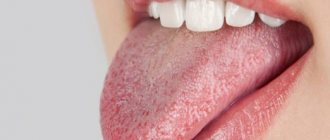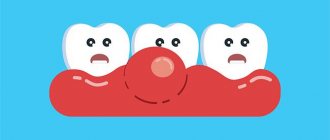Improper and irregular oral care means there is a high probability of getting some kind of infection, which can lead to gum disease. Gum papilloma is a form of oral disease that requires immediate treatment. It may also occur on the lips, tongue, larynx, and throat. Papillomas can be quite painful, and their development threatens inflammatory processes in the oral cavity.
Why do papillomas occur in children?
Once inside the body, the virus peacefully coexists with other microorganisms and does not manifest itself in any way until a certain point - when the child’s immunity weakens, benign growths may appear. The reasons for the appearance of papillomas in children are due to a decrease in natural protection in the case of:
- previous bacterial, viral and fungal infections;
- frequent colds;
- allergies;
- autoimmune pathologies;
- gastrointestinal diseases;
- immunodeficiency;
- long-term drug therapy;
- injuries, surgeries and burns;
- vitamin deficiency
Any attack on children's immunity can provoke virus activity. Sometimes the starting point is mental and physical overexertion, stress, and nervous shock.
HPV is highly contagious and can be transmitted even through short-term contact with a carrier. In children, 3 routes of infection with the human papillomavirus are most relevant.
- Perinatal. Passing through the vaginal canal during childbirth, the baby comes into contact with the physiological secretions of the mother, receiving a viral load. Another option for this method of infection is the transmission of HPV from the expectant mother to the fetus through the placental bloodstream during pregnancy.
- Domestic. This method is the most common reason for the appearance of papillomas on a child’s body. The virus is transmitted through surfaces and objects touched by an infected person. Common sources are towels, combs, general hygiene products, and clothing, from which HPV enters the child’s body through abrasions and small wounds.
- Contact. Transmission of the virus occurs when a healthy person comes into contact with the skin, hair or other parts of the carrier’s body. The simplest example of such an infection is playing and interacting with children who have rashes.
The incubation period lasts from 2–4 weeks to 3–6 months, less often up to 2–4 years. The optimal conditions for the development of HPV are a humid and warm environment. In the fresh air without contact with human skin, the virus quickly dies.
Symptoms of the development of gum papilloma
Papilloma is a benign tumor in the form of a characteristic growth. This formation can come in different sizes and shapes. Papilloma on the gum may not manifest itself in the form of pain or discomfort that bothers a person. This growth can be detected when visiting the dentist with complaints about teeth or gums, when the doctor conducts a professional examination of the entire oral cavity.
Papilloma is felt by the patient as a foreign body, which, depending on its size, creates a feeling of discomfort. It prevents the free position and movement of the tongue, which provokes distortion of the speech apparatus. With a significant increase in papilloma on the gum, it becomes difficult to chew food.
HPV symptoms
The papilloma virus infects the skin and mucous membranes, causing the proliferation of the epidermis and the appearance of pathological neoplasms:
- papillomas;
- warts;
- condylomas.
They look like small skin growths ranging in size from 1 to 5–8 mm, sometimes there are growths reaching 1–2 cm. Basically, such formations imitate healthy skin in color, but there are elements of dark brown and white shades.
The main places of distribution of papillomas:
- face and neck;
- external genitalia and groin area;
- the inner surface of the elbow and knee bends;
- soles of feet;
- fingers and skin around nails.
On the mucous membranes, elements can appear in the larynx, nasal passages; in girls, sometimes there are formations localized on the cervix.
Types of formations
There are several types of papillomas.
- Vulgar (common) warts. They are the most common type of neoplasm. They have a “leg”, rise noticeably above the surface of healthy skin, reaching a diameter of up to 1–2 cm. Sometimes hair grows from the central part of the wart. Such formations do not bother the child with pain or itching and appear on the arms, back or legs.
- Flat or juvenile papillomas. They look like small pigmented plaques of a fuzzy round shape, do not extend beyond the skin and form in groups. Such elements are characterized by a smooth surface and selectivity: they appear on the face, neck, legs, sometimes hands, but never in the armpits, genitals or skin folds. Occurs in children older than 5–6 years.
- Condylomas or genital papillomas. These elements resemble small papillae. They are pink in color and form in areas with thin skin: in the genital area, on the mucous membranes.
- Plantar warts. They affect the feet, occur under the big toes and visually resemble small round calluses.
Another variant of formations is filamentous warts or acrochords. They are similar to regular ones, but differ in elasticity and more compact sizes up to 5–6 mm. They prefer to appear under the mammary glands, in the groin, armpits, and are found on the neck and face.
The dangers of human papillomavirus
Some of the representatives of these microorganisms are harmless to humans, while others can provoke the growth of cancer cells. HPV is classified into two main types:
- Strains with high oncogenic risk. Such variants of the virus provoke the development of condylomas on the mucous membranes and in the genital area. Under unfavorable circumstances, they can cause an oncogenic mutation.
- Strains with low oncogenic risk. Viruses of this type cause warts, plantar lesions and juvenile papillomas. The risk of cell degeneration is minimal.
The greatest danger lies in girls: studies conducted in the USA have proven that 98% of cases of cervical cancer are associated with this virus. There is also a risk of developing cancer of the vagina, ovaries, anal canal, larynx, pharynx, and in boys, the genitals. Papillomas located in the anus and genital area require special attention.
Gum fibromatosis: treatment
For successful treatment of drug and hormonal forms of the disease, it is sufficient to eliminate the underlying cause (replacement of medication, elimination of hormone imbalance). The main method of treating hereditary gum hypertrophy is regular surgical treatment with a scalpel or laser. Moreover, each course of surgical intervention is carried out in stages and takes several weeks.
Sequence of surgical procedures:
- introduction of anesthesia - infiltration or conduction;
- excision of fibrous growths;
- removal of all loose teeth (if necessary);
- antiseptic treatment of the wound and application of a special membrane.
The healing process takes 1–2 weeks, after which the procedure is repeated on the other jaw. The frequency of procedures is individual and depends on the rate of progression of fibromatosis.
Diagnosis of HPV
The main clinical sign of papillomatous infection is formation on the skin. Therefore, in most cases, an examination by a doctor is sufficient to make a correct diagnosis. Additional examination methods are:
- biopsy or scraping - taking biological material for further research;
- PCR (polymerase chain reaction);
- General and biochemical blood test.
These laboratory diagnostic methods help:
- detect the presence of papilloma virus in the child’s body (if there are no growths on the skin);
- accurately determine the HPV strain;
- understand the form of the infection (acute or chronic).
These data are necessary for assessing oncogenic risk and timely further examination.
Rehabilitation period after excision of papilloma in the oral cavity
After surgery for papilloma with any of the destructive methods, a recovery period follows, which includes drug treatment and compliance with a number of recommendations of the attending physician (treatment of the oral cavity with medications, proper nutrition, etc.).
As a rule, drug therapy after cauterization of papilloma includes taking antiviral and immunostimulating drugs, as well as vitamins. In the presence of infectious diseases that can provoke an exacerbation of HPV, appropriate medications are prescribed to combat this pathology. Complex treatment will block the virus, speed up the healing of mucous membranes and prevent infection of the postoperative wound.
You can remove papilloma in the oral cavity using one of the destructive methods in our specialized medical center, where experienced and highly qualified specialists work. After the necessary examination, taking into account the patient’s wishes and medical indications, the doctor will select the most appropriate tactics to combat warts. An individual approach to the patient, high professionalism of doctors and the use of advanced equipment will ensure successful and safe treatment of papillomas in the oral cavity.
Attention!
This article is posted for informational purposes only and under no circumstances constitutes scientific material or medical advice and should not serve as a substitute for an in-person consultation with a professional physician.
For diagnostics, diagnosis and treatment, contact qualified doctors! Number of reads: 5580 Date of publication: 08/06/2018
Dermatologists - search service and appointment with dermatologists in Moscow
Treatment of HPV in children
Unfortunately, there are no effective medications for the treatment of papillomavirus in children, as well as in adults.
In most cases, the body copes on its own, and action is only necessary in situations where there is a risk of oncological processes or tumors interfere with the child’s daily life. What do they do if children develop papillomas?
- Do not panic. In the vast majority of cases, warts and other growths go away on their own within 2–3 years. The human papillomavirus is not only easily transmitted, but also quickly “leaves” the child’s body without any consequences or external help.
- Do not try to remove the growths at home, do not tear off or cut off under any circumstances. This is fraught with infection and the extensive appearance of new rashes.
- Contact a dermatologist if any suspicious elements appear on your child’s skin. During the consultation, the doctor will examine and give recommendations, and, if necessary, prescribe removal.
Medical care for manifestations of HPV is limited to the removal of formations that affect the quality of life or are located in places where they are often injured and cause discomfort (on the eyelid, in the genital area, in the larynx).
An extraordinary inspection is needed if:
- the color of the papilloma changes;
- the wart begins to grow or change shape;
- blood or other fluid is released from the formation;
- papilloma is subject to constant friction due to clothing;
- the rashes are on the face or mucous membranes.
It is advisable not to delay a visit to a dermatologist if the formation itches, hurts, causes other physical discomfort, or has been injured. In other cases, it is recommended to observe the “behavior” of the papilloma virus and control the elements on the child’s body.
Options for removing papillomas
There are 5 modern and proven methods, each of which has its own limitations, features and advantages.
- Electrocoagulation. The method is based on the influence of high-frequency electric current. It literally “burns out” the neoplasm, leaving in its place only a dry crust, which eventually falls off on its own.
- Radio wave surgery. This method allows you to remove warts and other elements without contact with the skin, which eliminates the risk of thermal damage to tissue.
- Laser therapy. It involves treating the affected area with light waves of a certain length.
- Cryodestruction. It involves “freezing” new growths with liquid nitrogen.
- Surgical excision. It is performed under local anesthesia using a scalpel.
It is strictly not recommended in childhood to resort to traditional methods of removing warts and to use medications from the pharmacy on your own without the supervision of a doctor. After removal of papillomas, children should not:
- tear off the crust;
- sunbathe;
- visit the baths;
- cover the treatment area with a plaster;
- scratch and rub the removal site.
You should not use creams and ointments without a dermatologist's prescription. In the first 1–4 days, it is advisable to refrain from walking in direct sunlight, swimming in public bodies of water and activities that can injure the treated area of skin.
Reasons for the proliferation of papillomas
Most people become acquainted with papillomavirus in the womb. It is transmitted to the fetus during the period of formation, so the child may be born with a small bump on the gum or tongue.
If its presence does not affect the ability to latch onto the breast and pacifier, the defect is left and removed after a few months, when the body gets a little stronger. Some experts believe that the problem is transmitted at the genetic level.
Other possible routes of infection include:
- scratches and sores on the baby’s gums;
- open wounds during the period of teething or changing teeth;
- during blood transfusions or operations;
- sharing a toothbrush, cup, towel with parents;
- The habit of some mothers is to lick a pacifier that has fallen on the floor and re-give it to the baby without treatment.
The virus does not have a specific incubation period. Once in the body, it may not manifest itself for many months or even years. In some patients, painless growths never appear, although a blood test shows the presence of a pathogenic strain.
Studies have shown that papilloma in the mouth of a child or adult often appears against the background of severe stress to the body.
One of the factors serves as an unpleasant “catalyst” that triggers the defective process of cell division:
- hypothermia;
- colds;
- stress after visiting kindergarten or school;
- exacerbation of congenital pathologies of the endocrine system, intestines or liver.
If a papilloma grows above a child’s teeth, it prevents the baby from making “wheezing” sounds. It can be easily damaged by a fork or the sharp edge of a toy, or caught when eating crackers or other hard foods. They begin to grow and cover the inner surface of the lips, the mucous membrane on the cheeks and under the tongue. Therefore, dentists recommend removing such formations.
HPV prevention
The most effective method of preventing infections and complications caused by the human papillomavirus is vaccination. It is carried out before the onset of full puberty and before the start of sexual relations. The optimal age is from 9 to 11 years.
Other preventive measures are:
- maintaining a healthy lifestyle;
- balanced healthy diet;
- timely treatment of abrasions, scratches and other skin damage;
- informing children and adolescents about the dangers of smoking, since tobacco use increases the risk of oncogenic mutations of the virus;
- regular preventive examinations.
It is very important to monitor the child’s health and support immunity in accessible ways. Active physical activity, hardening, and outdoor games are encouraged, allowing the formation of an adequate immune response to environmental factors. It is advisable to abandon home self-medication and uncontrolled use of medications, since incorrect actions can reduce the natural defenses of the child’s body and lead to the activation of HPV.
Are papilloma and condyloma the same thing?
Genital condylomas in the perineal area are sometimes single, and sometimes look like growths that resemble cauliflower in appearance. Sometimes these formations cause itching, irritation when touched, and sometimes they bleed. SM-Clinic doctors are often approached by patients who, having seen enough advertising, have been treated for years with “one pill” for supposed “exacerbations” of candidiasis (thrush). Upon examination, it turns out that the smear in such patients is normal, and the often recurring itching is actually caused by condylomas.
Who is at risk of getting the papilloma virus?
Papillomas and condylomas can appear, disappear and appear again, because they are manifestations of a viral infection, and their presence depends on the state of the body’s defenses at the moment, that is, immunity. Infection is most likely among smokers and alcoholics, and among those who are indiscriminate in sexual relations.
Women who use oral contraceptives (COCs) for a long time are also at risk of contracting the virus. The carrier of the virus can be both old and young. It is enough for your body to experience internal stress of various origins: you have had the flu or ARVI, gastrointestinal problems have worsened, your body cannot cope with long-term medication use - and here you have a weakened immune system, and with it the papillomavirus.
It is enough to be in close contact or live next to a person carrying the virus, take a swim in a “dirty” pool or shower in a public bath, or just walk along the beach - and if your immune system fails, the virus will invade your life. The papillomavirus “loves” heat and high humidity, when your skin is not protected by clothing. He immediately finds refuge on your heated skin.
